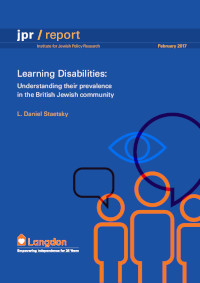Learning disabilities: Understanding their prevalence in the British Jewish community
Author(s)
Publication Date
February 2017
Publication Place
Publisher
Abstract
This study, originally commissioned by the Jewish learning disabilities charity, Langdon, draws on multiple data sources from the UK and around the world to estimate how many, and what proportions, of the Jewish population in the UK have some kind of learning disability.
Learning disabilities range in severity, from fairly mild learning difficulties such as dyslexia or dyspraxia, to much more severe cases such as Down's syndrome. This study looks at the full range, dividing the data into distinct categories, in order to provide estimates for organisations and charities working in this area of how many Jewish people in the UK are affected.
The report finds that just over 1% of British Jews has a severe or borderline learning disability, and a further 6% has some kind of mild learning difficulty. Prevalence among males is noticeably higher than among females.
The appendix to the report contains detailed data tables designed to be used by organisations and charities working in this area, to enable them to determine the probable scale of need according to severity of condition, age, sex, geographical area and religiosity.
Learning disabilities range in severity, from fairly mild learning difficulties such as dyslexia or dyspraxia, to much more severe cases such as Down's syndrome. This study looks at the full range, dividing the data into distinct categories, in order to provide estimates for organisations and charities working in this area of how many Jewish people in the UK are affected.
The report finds that just over 1% of British Jews has a severe or borderline learning disability, and a further 6% has some kind of mild learning difficulty. Prevalence among males is noticeably higher than among females.
The appendix to the report contains detailed data tables designed to be used by organisations and charities working in this area, to enable them to determine the probable scale of need according to severity of condition, age, sex, geographical area and religiosity.
Topics
Funder
Genre
Geographic Coverage
Copyright Holder
Original Language
Link
Bibliographic Information
Learning disabilities: Understanding their prevalence in the British Jewish community. . February 2017: https://archive.jpr.org.uk/object-uk430




